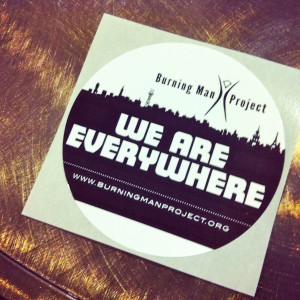On Saturday a group of polite, modestly dressed adults gathered in the Colorado Room of the Garden Hilton where they stood around chatting. A man looked out the rain streaked window and commented on how fast the city has changed. Aside from one woman with pink hair, it looked and felt like every other professional meet up at SXSWi.
Appearances can be deceiving.
Every person in that room had at one time been in a dried up desert lakebed where they constructed a temporary city with 50,000 other people. They co-exist for a week where no social boundaries exist, clothing is optional, there is a smoke cloud from more than just bonfires, and creativity reigns supreme. Then they scatter, disappearing back into the mainstream for another year. This is Burning Man.
So what do mud rolling hippies and Mac touting nerds have in common at SXSWi? Well, as the Burners say, “We Are Everywhere.”
 Naked in the desert by night sometimes means software engineer by day. And the actual Burning Man event is an incredibly intricately designed organism; there are board members, a security force (who are trained in non-violent mediation), and a digital media team. Their execution is just a little different.
Naked in the desert by night sometimes means software engineer by day. And the actual Burning Man event is an incredibly intricately designed organism; there are board members, a security force (who are trained in non-violent mediation), and a digital media team. Their execution is just a little different.
Kat Steinmetz of Burning Man was on a panel Saturday with other non-traditionally run organizations (Zappos, Second Life, Amgen, and a representative from MIT) to discuss “Decentralized Organizations: Do They Work?“.
After talking to some of the board members, Burning Man had its roots in social media long before social media was a thing. They had an analog Facebook-esqe site (when Zuckerberg was still just a glint in his daddy’s eye), and other forms of outreach to get free spirits from across the land to migrate to a desert for a week so that they can do…whatever it is that they do there.
Communications manager, Andie Grace, talks about Silicon Valley Burners, and how the event grew up with the Internet.
